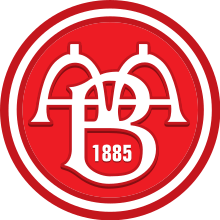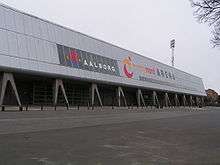AaB Fodbold
AaB,[2] (full name: Aalborg Boldspilklub, pronounced [ˈʌlˌpɒˀ ˈpʌlˀtspe̝lˌkʰlup]) internationally referred to as Aalborg BK[3] is a professional football team located in Aalborg. The club is represented in the Danish Superliga and has won four Danish football Championships and three Danish Cup trophies. Most recently the team won the double in 2014.
 | |||
| Full name | Aalborg Boldspilklub | ||
|---|---|---|---|
| Short name | AaB | ||
| Founded | 13 May 1885 | ||
| Ground | Nordjyske Arena, Aalborg | ||
| Capacity | 13,800[1] (7,700 seated) | ||
| Owner | AaB A/S | ||
| Sports director | Inge Andre Olsen | ||
| Head coach | Jacob Friis | ||
| League | Danish Superliga | ||
| 2018–19 | Superliga, 9th | ||
| Website | Club website | ||
|
| |||
In 1995 AaB became the first Danish team to participate in the UEFA Champions League group stage when they were awarded a place because Dynamo Kiev was expelled from the tournament after one game for attempted match-fixing. AaB qualified for the 2008–09 Champions League and is with two appearances the Danish club who has participated the second most in the tournament after F.C. Copenhagen.
History
Aalborg BK was part of the top-flight Danish leagues from the 1928–29 season, until the relegation of the club in 1947. The club returned to the best league in 1963, and except from the years of 1972, 1978 and 1981–1986, Aalborg BK has since been a part of the various editions of the Danish football championship. Despite its many years in the Danish championship, the club never won a championship title, but Aalborg BK won the Danish Cup competition in 1966 and 1970. Paid football was introduced in Denmark by the Danish Football Association in 1978. As Aalborg BK returned to the best Danish league, the club founded the professional branch of AaB A/S in 1987 to run a professional football team.[4]
Through the 1990s, the club won its first two Danish championships. In the Danish Superliga 1994-95 season, 24 goals from league topscorer Erik Bo Andersen secured the championship title for the team of coach Poul Erik Andreasen. The club was initially eliminated by Dynamo Kyiv in the qualification matches for the UEFA Champions League 1995-96, but following a bribing scandal Kyiv was banned from the tournament and Aalborg BK entered in their place. Aalborg BK thus became the first Danish team to compete in the UEFA Champions League. As they managed a 2–1 home win over Panathinaikos and a 2–2 draw with Porto in the six matches the club played in the initial group stage, Aalborg BK was eliminated. Erik Bo Andersen left the club for Scottish club Rangers, but in Søren Frederiksen, the club found its next goal-getter. Though not the league top scorer, Frederiksen scored 17 goals in the Danish Superliga 1998-99 which the club won under guidance of Swedish coach Hans Backe. Once again, Aalborg BK faced Dinamo Kyiv in the Champions League qualification, but again felt short, losing 1–2 at home and drawing 2–2 in Kyiv after a late Aalborg BK goal was disallowed for being behind the goal line.
Since then, the club established itself in the top half of the Superliga and won a bronze medal and qualified for the 2007 UEFA Intertoto Cup. Aalborg beat Honka on the away goals rule (2–2 in Finland and 1–1 in Denmark) in the second round, and in the third and final round Aalborg BK faced Gent and drew, 1–1, in the away game but beat them 2–1 in the following home match. Thus they "won" a place in the UEFA Cup's second qualification round and met HJK, the first match ended 2–1 to Helsinki, but in the last match Aalborg BK won 3–0 and were thus ready for the UEFA Cup 2007-08. Drawing the Italian team Sampdoria in the First Round, which have Antonio Cassano and Vincenzo Montella as notable players, made the task seem impossible. Aalborg made it again on the away goal rule (getting 2–2 in Genoa and managing 0–0 in Aalborg), and qualified for the group stage – being the first Danish team ever, to send an Italian team "out of Europe." In the group stage Aalborg BK was seeded in the lowest pot, and drew Anderlecht, Tottenham Hotspur, Getafe, and Hapoel Tel Aviv. Drawing with Anderlecht at home, and losing 2–3 to Tottenham (after being ahead 2–0 after the first half) forced Aalborg to win at home against Getafe, a match Aalborg BK lost 1–2.
In the 2007–08 season, Aalborg won their third Danish Championship and qualified for the 2008–09 UEFA Champions League qualifying rounds. in the second qualifying round, Aalborg easily eliminated FK Modriča 7–1 on aggregate. In the third round, before the group stage, they defeated FBK Kaunas 2–0 both at home and away and reached the group stage of the Champions League for the second time, the first time a Danish team achieved this. In the group stage, they were drawn in Group E along with defending champions Manchester United, Villarreal and Celtic. Aalborg finished third in the group, ahead of Celtic, with 6 points and progressed to the 2008–09 UEFA Cup knockout stage.
Their first match in their UEFA Cup run was against Spanish side Deportivo de La Coruña. Aalborg BK won the first leg at home 3–0 and the second leg at the Estadio Riazor 1–3, securing a 6–1 aggregate. Aalborg BK thereby earned a place among the last 16 teams. where they faced Manchester City. After a 2–0 loss in Manchester in the first leg Aalborg BK fought back to tie the score with a 2–0 win at home. The tie ended in agony however, as Aalborg were defeated by 4–3 on penalties.
On 11 May 2014, the club won their 4th Danish Championship, and four days later the double was secured, as the club defeated F.C. Copenhagen 4–2 in the Cup final.
Stadium

Since 1920, Aalborg BK has played its games at Aalborg Stadion. The stadium was opened on 18 July 1920 with a north-south aligned playing field. The first spectator seats were built in 1927, and in 1937 a wooden terrace for 3,000 standing spectators was built. In 1960, the stadium burned down and a new east-western aligned concrete stadium was opened in 1962. In recent years the stadium has been enlarged and rebuilt so that it now has modern facilities and roof over all spectator stands.[5] The stadium currently has a capacity of 13,997 people (8,997 seats) or 10,500 people (all seats).
Players
Current squad
- As of 2 June 2020[6]
Note: Flags indicate national team as defined under FIFA eligibility rules. Players may hold more than one non-FIFA nationality.
|
|
Out on loan
Note: Flags indicate national team as defined under FIFA eligibility rules. Players may hold more than one non-FIFA nationality.
|
|
Retired numbers
12 – ![]()
Notable former players
Current management
- Sports director Inge Andre Olsen (2020–)
- Head coach Jacob Friis (2018–)
- Assistant coach Allan K. Jepsen (2019–)
- Assistant coach Lasse Stensgaard (2019–)
- Goalkeeping coach Poul Buus (2007–)
- Physical trainer Ashley Tootle (2017–)
AaB Fodbold is owned by AaB A/S.
Head coaches
The following managers have coached AaB since it re-entered the Danish top-flight in 1986:

















Honours
Domestic
Leagues
- Danish Superliga
- Danish 1st Division
- Winner (2): 1962, 1978
- Danish 2nd Division
- Winner (1): 1984
- 49 seasons in the Highest Danish League
- 19 seasons in the Second Highest Danish League
- 5 seasons in the Third Highest Danish League
Cups
- Danish Cup
- Danish Supercup

- Viasat Cup

- Provinsmesterskabsturneringen


Superliga history

Season Pos. Pl. W D L GS GA P Cup 1991 SL 6 18 6 5 7 29 33 17 final 1991–92 SL 6 32 10 12 10 45 44 32 quarter-final 1992–93 SL 4 32 12 12 8 48 40 36 final 1993–94 SL 5 32 8 15 9 46 44 31 quarter-final 1994–95 SL 1 32 19 6 7 74 38 44 semi-final 1995–96 SL 5 33 15 6 12 57 38 51 quarter-final 1996–97 SL 5 33 12 11 10 46 40 47 quarter-final 1997–98 SL 7 33 12 8 13 54 48 44 quarter-final 1998–99 SL 1 33 17 13 3 65 37 64 final 1999–00 SL 5 33 12 13 8 57 40 49 final 2000–01 SL 5 33 13 10 10 51 49 49 5th round 2001–02 SL 4 33 16 6 11 52 45 54 quarter-final 2002–03 SL 6 33 14 4 15 42 45 46 semi-final 2003–04 SL 5 33 16 9 8 55 41 57 final 2004–05 SL 4 33 15 8 10 59 45 53 5th round 2005–06 SL 5 33 11 12 10 48 44 45 semi-final 2006–07 SL 3 33 18 7 8 55 34 61 2nd round 2007–08 SL 1 33 22 5 6 60 38 71 4th round 2008–09 SL 7 33 9 12 12 40 49 39 final 2009–10 SL 5 33 13 9 11 36 30 48 4th round 2010–11 SL 10 33 8 11 14 38 48 35 quarter-final 2011–12 SL 7 33 12 8 13 42 48 44 2nd round 2012–13 SL 5 33 13 8 12 51 46 47 4th round 2013–14 SL 1 33 18 8 7 60 38 62 Winner 2014–15 SL 5 33 13 9 11 39 31 48 quarter-final 2015–16 SL 5 33 15 5 13 56 44 50 semi-final 2016–17 SL 10 34 10 8 16 31 49 38 quarter-final 2017–18 SL 5 36 10 15 11 38 44 45 quarter-final 2017–18 SL 9 34 10 12 12 44 44 42 semi-final
References
- "AaB's hjemmebane - Aalborg Portland Park". aabsport.dk. Retrieved 27 November 2017.
- Årsrapport for 2011 Archived 23 July 2014 at the Wayback Machine, Aalborg Boldspilklub A/S, p.9
- Denmark – Danish Super League UEFA.com
- (in Danish) Om Aalborg Boldspilklub af 1885 Archived 8 March 2008 at the Wayback Machine at Aalborg Boldspilklub af 1885
- (in Danish) Aalborg Stadion 1920–2001, Aalborg.dk, 8 February 2006
- https://aabsport.dk/holdet/spillertruppen/
External links
- (in Danish) Official website
- Aalborg BK UEFA.com
- (in Danish) Aalborg Boldspilklub af 1885 (Amateur foundation)
- (in Danish) Aalborg Support Club (Official fanclub of AaB)
- (in Danish) AaBfan.dk (Amateur news site about AaB)